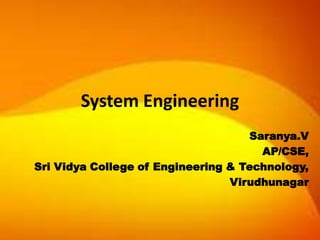
System engineering
- 1. System Engineering Saranya.V AP/CSE, Sri Vidya College of Engineering & Technology, Virudhunagar
- 2. • All aspects of computer based systems development including hardware and software process engineering. – Usually use Waterfall model – Little scope for iteration between phases because hardware changes are very expensive. Software may have to compensate for hardware problems.
- 3. • Much scope for misunderstanding here. • Different disciplines use a different vocabulary and much negotiation is required. • Engineers may have personal agendas to fulfill.
- 4. System Definition • Simply known as functional unit. – Executes user written programs – Performs user designated manipulation – Includes arithmetic logic operations – Use common storage access. – associated software’s
- 5. • System engineering focuses on how complex engineering projects should be designed and managed. • Define customer needs and required functionality early in the development life cycle, documenting.
- 6. System engineering process SIMILAR: • State the problem(customer needs) • Investigate alternatives • Model the system • Integrate (bringing elements together) • Launch the system (output) • Assess performance (evaluation criteria) • Re-evaluation
- 8. Requirements System definition decommissioning System System design evolution Sub system System development installation System integration
- 9. • Interaction between engineering: – All major engg integration – Bioinformatics: • Biotechnology • Information technology • etc
- 10. System engineering hierarchy • Model: – Simplified representation of a system. • Simulation – Computerized version of a model • Modeling and simulation is a discipline for developing a level of understanding of the interaction of the parts of a system.
- 11. Hierarchy • World view – Public health care, e governance trade and commerce, banking & finance. • Domain view – Concentrate on specific domain – Education • College, school, etc • Element view – Focuses on sub domain(Admission,exams,etc) • Detailed view – (internal marks, university, internal…)
- 12. Modeling the system • Explains how the system is working. • Elements of system modeling: – Inputs – Processes – Outcomes.
